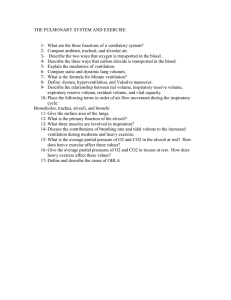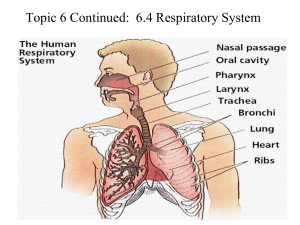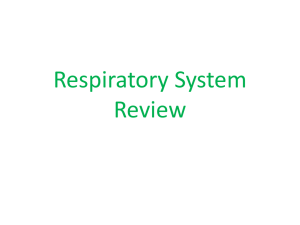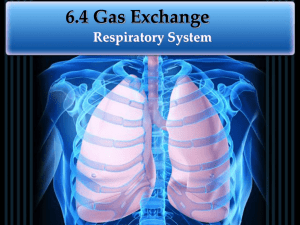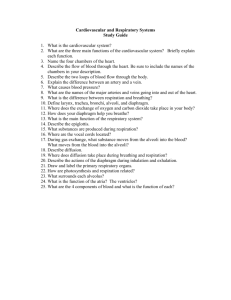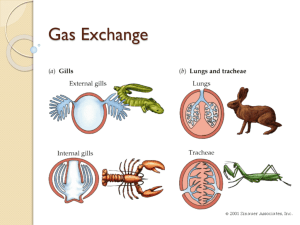Ventilation and Gas Exchange
advertisement
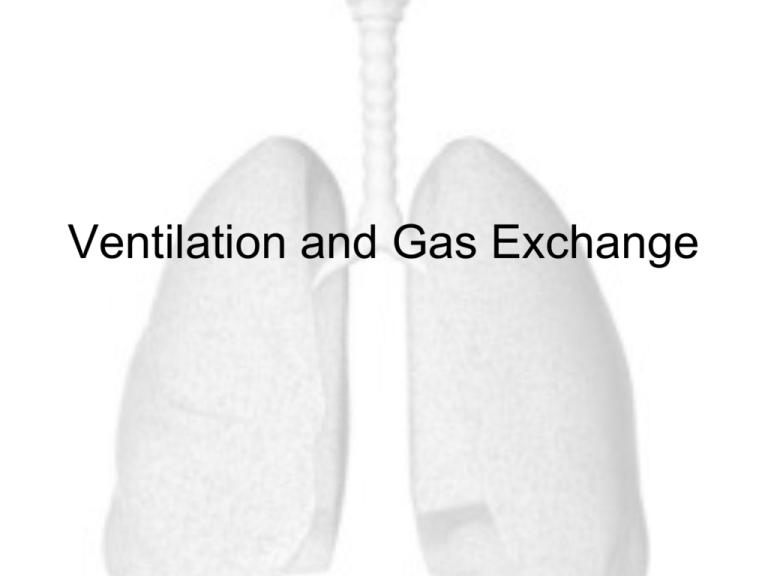
Ventilation and Gas Exchange This photo (courtesy of the Anatomical Institute, Bern) shows a rubber cast of human lungs The Human Respirator y System Assignment 1. Draw, label and annotate a diagram of the human ventilation system. Include a pull-out of the alveoli. What is cellular respiration? When an organism takes in organic nutrients and converts them to a usable for of energy, namely ATP. *****See your notes from last year to review this. Anything about cellular respiration is fair game for this exam.***** What is gas exchange? 1. Exchanging of oxygen and carbon dioxide in the capillaries of the alveoli 2. Based on concentration gradients 3. Does not require energy (because it uses diffusion) Bronchiole and Alveolar Structures Creative Commons (CC) Adaptations of the Alveoli 1. Large surface area = increases amount of diffusion that can occur 2. Thin epithelial layer = short diffusion distance for gases 3. Moist = prevents alveoli from sticking to each other 4. Surrounded by capillaries = large blood supply Creative Commons (CC) Creative Commons (CC) What is ventilation? 1. The mechanical action of the muscles surrounding the lungs moving air in and out (Air is refreshed with every ventilation) 2. Based on volume and pressure changes 3. Requires energy (muscle use) How does ventilation occur? Involves inspiration (inhaling) and expiration (exhaling) 1.Inspiration a. External intercostal muscles contract b. Pull ribs out and up c. Diaphragm contracts and flattens (or lowers) d. This allows a decrease in pressure and an increase in volume e. Air flows into the lungs How does ventilation occur? (cont.) Involves inspiration (inhaling) and expiration (exhaling) 2. Expiration a. Internal intercostal muscles contract b. Pull rib cage in and down c. Diaphragm relaxes and moves upward d. Creates and increase in pressure and a decrease in volume e. Air is forced out of the lungs Internal intercostals External intercostals Variations in lung volume Why do we need a ventilation system? 1. Related to the surface are to volume ratio 2. As organisms get larger the ratio decreases 3. We don’t have enough surface area for efficient gas exchange. 4. It would take too long for the gases to reach our organs through diffusion alone because our volume is too large. 5. Instead of diffusion from the body’s surface, the alveoli’s increased surface area and capillaries allow enough gas exchange to support the entire body 6. We need a constant supply of oxygen to all organs to support cellular respiration Examples of other ventilation systems 1. Insects have tracheal tubes running through out their bodies a. This allows diffusion of gas throughout b. Air enters or exits through the insects exoskeleton Creative Commons (CC) Examples of other ventilation systems 1. Larval amphibians have external gills a. Have large surface are to aid gas exchange b. Work similar to lungs and alveoli to exchange gases c. Easily damaged because of location d. Example: salamander Creative Commons (CC) Examples of other ventilation systems 1. Fish have internal gills a. These are the same as external gills but are protected b. As the fish opens or moves its mouth water flows in c. As the fish closes its mouth or continues movement water is forced through the gills and gill slits d. The gills provide a surface Examples of respiration without a ventilation system or circulation 1. 2. 3. 4. 5. 6. Bacteria Fungi Flatworms Sponges Jellyfish Plants Assignment 1. Explain how ventilation, gas exchange and cellular respiration are interdependent. Asthma
